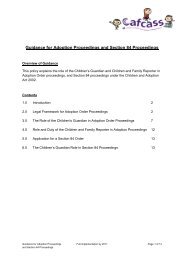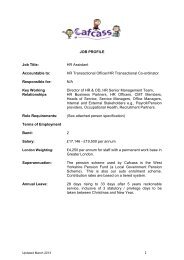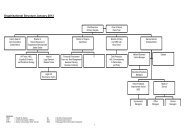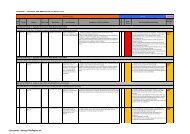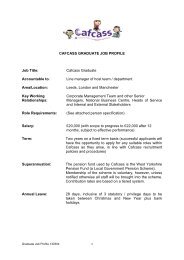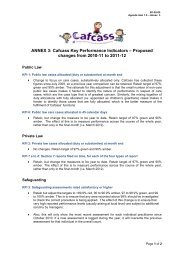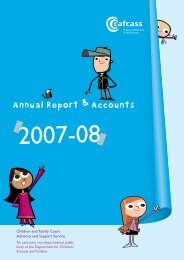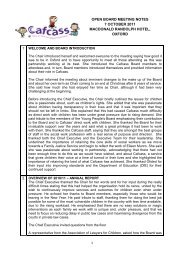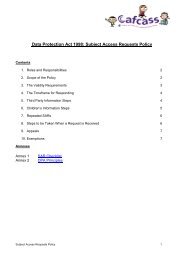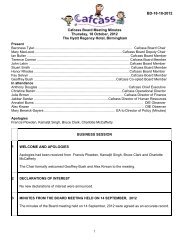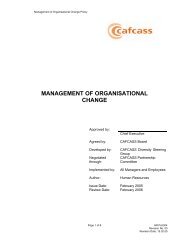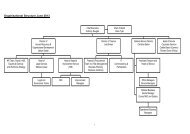POLICY DEVELOPMENT FRAMEWORK - Cafcass
POLICY DEVELOPMENT FRAMEWORK - Cafcass
POLICY DEVELOPMENT FRAMEWORK - Cafcass
Create successful ePaper yourself
Turn your PDF publications into a flip-book with our unique Google optimized e-Paper software.
4.0 GUIDANCE FOR <strong>POLICY</strong> <strong>DEVELOPMENT</strong><br />
4.1 When developing a policy the difference between policy, procedure and<br />
guidance, and quite what goes where, can often cause confusion. The policy<br />
must make clear what the aims, or broad principles of the policy are and<br />
explain how the policy will achieve them and contribute to the overall direction<br />
of <strong>Cafcass</strong>. Generally, procedures follow on from policy - they provide a clear<br />
explanation of what 'must be done' in order to implement the policy and<br />
compliance is compulsory for staff. Procedures can be a separate document, a<br />
section of the policy or emboldened within the policy document so that they are<br />
easily differentiated from guidance. The guidance section of a policy will usually<br />
include supporting information about good practice and make suggestions on<br />
the practicalities of how to implement the policy.<br />
PHASE ONE - Getting Started - The Process of Policy Development<br />
4.2 The process of developing a policy will often be a complex and an organic<br />
development, however, there tends to be a number of key steps to developing<br />
a robust policy document. These are:<br />
a. Step 1 - the policy justification - at the beginning of a policy development it is<br />
essential to be clear about the purpose of the policy and how the policy will help to<br />
resolve the problem that we are trying to fix. For example, consider whether a policy is<br />
the right method for resolving the problem, or is another approach or combination of<br />
approaches likely to be more appropriate? When thinking through the options it is<br />
important to be clear about the boundaries of what a policy will and will not be able to<br />
resolve and to consider what this may mean for other areas such as training,<br />
performance information and quality assurance tools. Depending upon the nature and<br />
scale of the policy it may be useful to select an advisory group to contribute to this<br />
early 'scoping' of the policy. It is at this early planning stage when it may be<br />
appropriate to develop a business case. (See the template in the resources pack).<br />
b. Step 2 - research, analysis & direction setting - It is essential to spend time<br />
gathering and analysing information about what we currently know of the nature of the<br />
problem we are trying to fix, to gain views, ideas and analyse information from<br />
<strong>Cafcass</strong> as well as looking for lessons learnt and good practice that we can apply from<br />
other organisations. It is also useful to test out any assumptions that have been made<br />
at this stage. This stage will usually run alongside the business case development<br />
stage.<br />
c. Stage 3 - policy design - In reaching this stage you should have a good idea how the<br />
policy will support the organisations overall strategic direction and resolve the problem<br />
or difficulties in question. Therefore this stage usually involves the identification of the<br />
guiding principles of the policy, possibly a definition of vision, and clear aims and<br />
objectives.<br />
Page 4 of 4____________________________________________________________________ <strong>POLICY</strong> <strong>DEVELOPMENT</strong> <strong>FRAMEWORK</strong>



